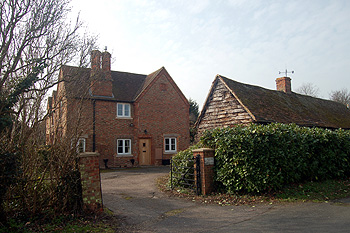Church Farm Wilshamstead

Church Farm March 2012
Today Vicarage Lane is largely a modern housing development dating from the mid 1960s [RDBP6/62/30]. Before that it was largely rural in character and housed two farms – Church Farm and Little Church Farm. The farmhouse was listed by the former Department of Environment in June 1974 as Grade II, of special interest.
The house has a plaque: “R. L. 1847” indicating that it was built by Richard Lowndes in that year. It is constructed from mottled brick with red brick dressings and has clay tiled roofs. We know that Richard Lowndes bought the farm, then comprising 189 acres, 3 roods, 31 poles, for £6,150 from the trustees of a man named Croke in 1845 [Fac148/2]. It was then occupied by John Armstrong who paid rent of £230, Lowndes also bought 21, 1 rood, 6 poles referred to as the Tithe Closes for £1,100, in the occupation of Thomas James whose rent was £42 per annum. The whole estate was liable to paying a third of the cost of repairs to the chancel of Wilshamstead church. A map of 1848 [SF80/11] shows the following pieces of land belonging to the farm:
- The Hill – 47 acres, 2 roods, 6 poles of arable;
- Doggetts – 7 acres, 3 roods, 9 poles of arable;
- Doggetts – 9 acres, 2 roods, 3 poles of pasture;
- Weston Down Side – 10 acres, 33 poles of arable;
- West Field – 15 acres, 2 roods, 1 pole of pasture;
- Spinney Field – 67 acres, 28 poles of arable;
- A spinney of 1 acre, 2 roods, 15 poles;
- Home Close – 22 acres, 12 poles of pasture;
- Banky Close – 7 acres, 3 roods of pasture;
- The house and homestead covered 1 acres, 3 roods.
This made a total of 190 acres, 30 poles, a difference perhaps brought about by re-measuring. Tithe Closes comprised:
- Barn Close – 2 acres, 13 poles of meadow;
- Further Close – 6 acres, 1 rood, 25 poles of meadow;
- Little Mead – 3 acres, 1 rood, 8 poles of meadow;
- Great Mead – 9 acres 2 roods of meadow
By September 1862 the farm’s owner was William Layton Lowndes and a new tenancy agreement was made with John Armstrong, whose rent was still the £230 of 1845. Armstrong died in 1872 and was succeeded by Joseph Simms, also tenant of Wilstead Cotton End Manor Farm, and the rent now rose to £300 per annum.
The vicar died in 1871 and Lowndes paid his successor £115, of which £40/12/8 was for chancel repairs and £94/7/4 a voluntary contribution towards the restoration of the church which was re-consecrated on 24th April 1873. Simms’ tenancy ran until he left in 1881 and a man named Swaffield used the farm for a year, being succeeded by John Moore McDonald, also tenant of Manor Farm, at Michaelmas 1882. Mc Donald left the county for Leicester, seemingly in 1885 [SF74/23]. The following tenant seems to have been Noah Bottoms who stayed until 1891 [SF74/31]. He was followed by William Preston who stayed until at least 1902.
Directories for Bedfordshire were not published every year but every few years from the early to mid 19th century until 1940. Kelly’s Directory lists the tenant in 1906 and 1910 as Ernest Sinfield, in 1914 as William and James Soper and in 1924 as George Throssell. In 1913 planning permission for a cow house was applied for [RDBP1/227].
The Rating and Valuation Act 1925 specified that every building and piece of land in the country was to be assessed to determine its rateable value. Like most of the county, Wilshamstead was largely assessed in 1927 and the valuer visiting Church Farm [DV1/H42/14] found that it was now owned and occupied by Job Honour who now farmed 142 acres – a reduction of thirty eight.
The farmhouse comprised two reception rooms, a kitchen, a scullery, a dairy and five bedrooms above. A washhouse, a wood barn, a coal barn, a garage and a coachhouse all stood outside. Water came from a pump.
The homestead contained: a stable for two horses; a cowhouse for three beasts; a loose box; two piggeries; a stable for five horses; a four bay open hovel; an implement hovel; a henhouse; a barn; a two bay open hovel; a cowhouse for thirty two; a feeding house; a hay store; two calf pens; a shed used as a store; a five bay cart hovel and a cooling house.